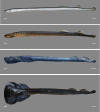Morphometric and physical characteristics distinguishing adult Patagonian lamprey, Geotria macrostoma from the pouched lamprey, Geotria australis
- PMID: 33951087
- PMCID: PMC8099125
- DOI: 10.1371/journal.pone.0250601
Morphometric and physical characteristics distinguishing adult Patagonian lamprey, Geotria macrostoma from the pouched lamprey, Geotria australis
Abstract
The pouched lamprey, Geotria australis Gray, 1851, has long been considered monotypic in the Geotriidae family with a wide southern temperate distribution across Australasia and South America. Recent studies have provided molecular and morphological evidence for a second Geotria species in South America; Geotria macrostoma (Burmeister, 1868). The aim of this study was to determine morphometric and physical characteristics of adult G. macrostoma that further differentiate this re-instated species of Geotriidae from G. australis. The diagnostic features discriminating immature adult G. macrostoma from G. australis when entering fresh water, are distinct differences in dentition, oral papillae and fimbriae counts and differences in coloration. In addition, G. macrostoma display greater growth of the prebranchial region and oral disc and has a deeper body depth and higher condition factor. All current ecological knowledge of the genus Geotria is based on Australasian populations, which may not be applicable to G. macrostoma. To ensure the conservation and protection of the Patagonian lamprey as a re-identified species, further investigations are needed to understand its life history, biology and ecology throughout its range.
Conflict of interest statement
Several authors are employed by commercial companies that undertake consultancy relating to freshwater fish ecology and indigenous knowledge (Kitson Consulting Ltd, National Institute of Water and Atmospheric Research Ltd, Marscco). This does not alter our adherence to PLOS ONE policies on sharing data and materials.
Figures













References
-
- Janvier P. Living primitive fishes and fishes from deep time. In: McKenzie DJ, Farrell AP, Brauner CJ, editors. Primitive fishes. Volume 26. Fish physiology. San Diego, USA: Academic Press; 2007. p. 1–51.
-
- Docker MF, Potter IC. Life history evolution in lampreys: alternative migratory and feeding types. In: Docker MF, editor. Lampreys: biology, conservation, and control. Vol. 2. Netherlands: Springer; 2019. p. 287–409.
-
- Potter IC, Gill HS, Renaud CB, Haoucher D. The taxonomy, phylogeny, and distribution of lampreys. In: Docker MF, editor. Lampreys: biology, conservation, and control. Vol. 1. Netherlands: Springer; 2015. p. 35–73.
-
- Clemens BJ. A call for standard terminology for lamprey life stages. Fisheries. 2019; 44(5): 243–5.
Publication types
MeSH terms
LinkOut - more resources
Full Text Sources

